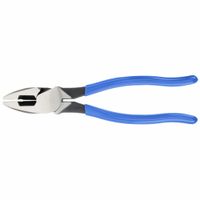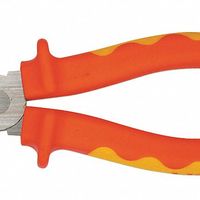Call +(254) 703 030 000 / 751 483 999 / 721 704 777
- Home
- Tools
- Hand Tools
- Pliers
- Lineman S Pliers
.....Read More
Frequently Asked Questions
What are lineman's pliers used for?
Lineman's pliers, also known as combination pliers, are versatile hand tools primarily used in electrical work and other trades. They are designed for gripping, twisting, bending, and cutting wire and cable. The pliers feature a robust, flat gripping surface near the jaws, which allows for a firm hold on objects, making them ideal for twisting wires together or pulling them through conduits.
The cutting edge of lineman's pliers is located near the pivot point, providing significant leverage for cutting through various gauges of wire, including copper, aluminum, and steel. This cutting capability is essential for electricians who need to trim wires to specific lengths or remove insulation.
Additionally, lineman's pliers often have a crimping feature, which is used to secure connectors onto the ends of cables. This is particularly useful in telecommunications and networking tasks where reliable connections are crucial.
The tool's design includes insulated handles, which provide protection against electric shock, making them safe for use in live electrical environments. The handles also offer ergonomic comfort, reducing hand fatigue during prolonged use.
Beyond electrical applications, lineman's pliers are used in construction, automotive repair, and general maintenance tasks. They can bend and shape metal components, remove nails, and even serve as a makeshift hammer in some situations.
Overall, lineman's pliers are an essential tool for professionals and DIY enthusiasts alike, offering a combination of strength, precision, and versatility for a wide range of tasks.
How do you maintain lineman's pliers?
To maintain lineman's pliers, follow these steps:
1. **Cleaning**: After each use, wipe the pliers with a clean, dry cloth to remove dirt, debris, and moisture. For stubborn grime, use a brush with stiff bristles or a toothbrush. If necessary, apply a mild detergent or rubbing alcohol for thorough cleaning, then dry completely.
2. **Lubrication**: Regularly apply a light machine oil or a specialized tool lubricant to the pivot joint. Open and close the pliers several times to ensure the lubricant penetrates the joint, ensuring smooth operation and preventing rust.
3. **Rust Prevention**: Store the pliers in a dry place to prevent rust. Consider using a rust inhibitor spray or a silicone-based lubricant on the metal surfaces. For long-term storage, wrap the pliers in a cloth or place them in a tool roll to protect them from moisture.
4. **Sharpening**: If the cutting edges become dull, sharpen them using a fine file or a sharpening stone. Carefully follow the original bevel angle to maintain the integrity of the cutting edge. Avoid over-sharpening, which can weaken the blades.
5. **Inspection**: Regularly inspect the pliers for signs of wear or damage, such as cracks in the handles or misalignment of the jaws. Address any issues promptly to ensure safety and effectiveness.
6. **Handle Care**: If the handles have rubber or plastic grips, check for wear or damage. Replace grips if they are cracked or loose to maintain a secure and comfortable grip.
7. **Storage**: Store the pliers in a toolbox or on a pegboard, ensuring they are not exposed to excessive humidity or corrosive environments. Keep them organized to prevent damage from other tools.
What is the difference between insulated and non-insulated lineman's pliers?
Insulated lineman's pliers are designed with a protective layer, usually made of rubber or plastic, that covers the handles. This insulation is specifically engineered to protect users from electrical shocks by preventing the conduction of electricity through the handles. These pliers are typically rated for a certain voltage level, often up to 1000 volts, and are used by electricians and other professionals who work with live electrical circuits. The insulation also provides a better grip, reducing the risk of slipping during use.
Non-insulated lineman's pliers, on the other hand, lack this protective layer. They are made entirely of metal, except for the handles, which may have a basic plastic or rubber coating for comfort and grip, but not for electrical protection. These pliers are suitable for general-purpose tasks such as cutting, twisting, and gripping wires, but they should not be used on live electrical circuits due to the risk of electrical shock.
The primary difference lies in the safety features: insulated pliers offer protection against electrical hazards, while non-insulated pliers do not. This makes insulated pliers essential for electrical work, whereas non-insulated pliers are more appropriate for mechanical tasks where electrical safety is not a concern.
How do you choose the right lineman's pliers for a job?
To choose the right lineman's pliers for a job, consider the following factors:
1. **Size and Length**: Select pliers that fit comfortably in your hand and are appropriate for the task. Common sizes range from 7 to 9 inches. Longer handles provide more leverage for cutting thicker wires.
2. **Material and Durability**: Opt for pliers made from high-quality, heat-treated steel for durability and strength. Chrome vanadium or alloy steel are good choices for long-lasting performance.
3. **Cutting Edge**: Ensure the cutting edges are sharp and aligned for clean cuts. Induction-hardened cutting edges offer better longevity and performance.
4. **Grip and Comfort**: Look for ergonomic handles with non-slip grips to reduce hand fatigue and improve control. Insulated handles are essential for electrical work to protect against electric shock.
5. **Jaw Design**: Choose pliers with a cross-hatched or serrated jaw design for a better grip on wires and other materials. This is crucial for twisting and pulling tasks.
6. **Functionality**: Consider additional features like crimping capabilities, fish tape pulling, or integrated wire strippers if the job requires multifunctional tools.
7. **Brand and Quality**: Reputable brands often offer better quality and warranties. Investing in a trusted brand can ensure reliability and safety.
8. **Job Specifics**: Match the pliers to the specific requirements of the job, such as the type and thickness of wire, the need for precision, or the working environment (e.g., wet or dry conditions).
9. **Budget**: Balance cost with quality. While higher-end pliers may be more expensive, they often provide better performance and longevity.
By considering these factors, you can select the most suitable lineman's pliers for your specific needs, ensuring efficiency and safety in your work.
Can lineman's pliers cut through thick cables?
Lineman's pliers, also known as combination pliers, are versatile tools primarily used for gripping, twisting, bending, and cutting wire and cable. They feature a robust design with a flat gripping surface near the pivot and cutting edges near the tip. While they are effective for cutting various types of wire, their ability to cut through thick cables depends on several factors:
1. **Cable Thickness and Material**: Lineman's pliers are generally suitable for cutting medium-gauge wires and cables, such as electrical wires and small to medium-sized copper or aluminum cables. However, they may struggle with very thick cables, especially those made of hardened steel or with multiple layers of insulation.
2. **Pliers Quality and Size**: The effectiveness of lineman's pliers in cutting thick cables also depends on the quality and size of the tool. High-quality pliers made from durable materials with sharp cutting edges can handle thicker cables more efficiently. Larger pliers provide more leverage, making it easier to cut through tougher materials.
3. **User Strength and Technique**: Cutting thick cables with lineman's pliers requires significant hand strength and proper technique. Applying steady pressure and ensuring the cable is positioned correctly between the cutting edges can improve cutting efficiency.
4. **Tool Condition**: The condition of the pliers is crucial. Dull or damaged cutting edges will struggle with thick cables, so maintaining the tool in good condition is essential for optimal performance.
For very thick or hardened cables, specialized tools like cable cutters or bolt cutters are recommended, as they are designed to handle such tasks more effectively and with less effort.
What safety precautions should be taken when using lineman's pliers?
1. **Inspect Tools**: Before use, check for any damage, such as cracks or rust, to ensure the pliers are in good condition.
2. **Wear Protective Gear**: Use safety glasses to protect your eyes from flying debris and gloves to enhance grip and protect your hands.
3. **Use Insulated Pliers**: When working with electrical wires, ensure the pliers are insulated to prevent electric shock.
4. **Proper Grip**: Hold the pliers firmly to maintain control and prevent slipping, which could cause injury.
5. **Correct Usage**: Use the pliers only for their intended purpose, such as cutting, twisting, or gripping wires, to avoid damaging the tool or causing injury.
6. **Avoid Overloading**: Do not apply excessive force that could cause the pliers to slip or break.
7. **Keep Work Area Clean**: Ensure the workspace is free of clutter to prevent accidents.
8. **Store Safely**: When not in use, store the pliers in a safe place to prevent accidental injury.
9. **Be Aware of Surroundings**: Ensure no one is in the immediate vicinity who could be injured by your actions.
10. **Regular Maintenance**: Clean and lubricate the pliers regularly to ensure smooth operation and longevity.
11. **Avoid Wet Conditions**: Do not use pliers in wet or damp conditions to prevent slipping and electric shock.
12. **Use Correct Size**: Select the appropriate size of pliers for the task to ensure efficiency and safety.
13. **Keep Fingers Clear**: Be mindful of finger placement to avoid pinching or cutting injuries.
14. **Training**: Ensure proper training in the use of lineman's pliers to understand their capabilities and limitations.
How do you properly clean and store lineman's pliers?
To properly clean and store lineman's pliers, follow these steps:
1. **Cleaning:**
- **Disassemble (if applicable):** If your pliers have removable parts, disassemble them for thorough cleaning.
- **Remove Debris:** Use a stiff brush or an old toothbrush to remove dirt, grime, and debris from the pliers, especially around the pivot joint.
- **Wash:** Wipe the pliers with a cloth dampened with warm, soapy water. Avoid submerging them in water to prevent rust.
- **Rust Removal:** If there is rust, use a rust remover or a mixture of vinegar and baking soda. Apply with a brush and scrub gently.
- **Rinse and Dry:** Rinse with clean water and dry thoroughly with a clean cloth to prevent moisture retention.
- **Lubricate:** Apply a few drops of light machine oil or a specialized tool lubricant to the pivot joint and moving parts. Wipe off excess oil with a cloth.
2. **Storage:**
- **Environment:** Store in a dry, cool place to prevent rust and corrosion. Avoid humid areas.
- **Toolbox or Rack:** Place the pliers in a toolbox with a designated spot or hang them on a tool rack to prevent damage and maintain organization.
- **Protective Coating:** Consider applying a thin layer of protective oil or a rust inhibitor spray before storage, especially if storing for an extended period.
- **Avoid Overcrowding:** Ensure the pliers are not overcrowded with other tools to prevent damage to the cutting edges and handles.
By following these steps, you can maintain the functionality and extend the lifespan of your lineman's pliers.


